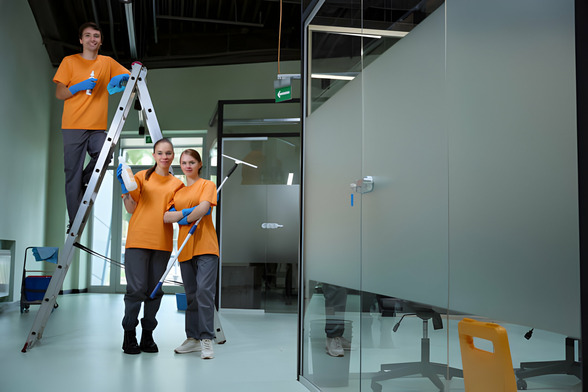
This is the ultimate guide to helping you understand the mysteries of deep cleaning and janitorial cleaning—the dynamic pair that keeps your office spotless. We will walk you through the subtle but important differences between the two cleaning techniques and help you determine which one your company actually needs. From deep cleaning to janitorial services, each section will highlight the distinct roles that these cleaning techniques play in keeping your workspace hygienic and safe.
See also our post on Janitorial Services: Essential Cleaning for Commercial Spaces
Understanding Janitorial Cleaning
Daily Maintenance
Janitorial cleaning focuses on daily maintenance tasks. It involves routine cleaning activities like sweeping, mopping, vacuuming, and trash removal to keep your workspace consistently clean.
Surface Cleaning
Janitors focus on surface cleaning. Their duties include dusting surfaces, wiping down countertops, and maintaining the overall cleanliness of visible areas to create a pleasant and inviting atmosphere.
Restroom Sanitization
Janitorial services prioritize restroom sanitization. Regular cleaning of restrooms ensures a hygienic environment, including the disinfection of surfaces, changing of hand towels, and restocking of essential supplies.
Quick Response to Spills
Janitors provide a quick response to spills and messes. Their immediate attention to accidents or spills helps prevent accidents, maintains safety, and keeps the workspace looking tidy.
Regular Maintenance Schedule
Janitorial cleaning operates on a regular maintenance schedule. Whether it’s daily, weekly, or customized to fit your business needs, the goal is to sustain a consistently clean environment.
Decoding Deep Cleaning
Intensive Cleaning
Deep cleaning involves more intensive cleaning tasks. It targets areas that might be overlooked in daily cleaning, focusing on hard-to-reach spots and hidden corners that accumulate dirt over time.
Thorough Floor Care
Deep cleaning includes thorough floor care. This goes beyond regular vacuuming and mopping, involving activities like carpet cleaning, floor polishing, and even addressing grout in tiled areas.
Comprehensive Dusting
Deep cleaning covers comprehensive dusting. It involves reaching high and low surfaces to eliminate accumulated dust, ensuring a healthier environment for everyone in the workspace.
Appliance and Furniture Cleaning
Deep cleaning addresses appliances and furniture. This includes cleaning behind and beneath appliances, as well as thorough cleaning of furniture to remove deep-seated dirt and allergens.
Periodic Implementation
Deep cleaning is implemented periodically. It is not a daily or weekly routine but occurs at intervals to provide a more intense cleaning that complements regular janitorial services.
How to Identify Your Business Needs
Assessing Foot Traffic
Consider foot traffic in your business. High foot traffic areas may benefit from more frequent janitorial cleaning, while deep cleaning could be scheduled as needed to address specific concerns.
Nature of Business Operations
Evaluate the nature of your business operations. If your business involves food preparation or healthcare services, where cleanliness is critical, a combination of janitorial and deep cleaning may be necessary.
Size and Layout of Workspace
Examine the size and layout of your workspace. Larger spaces may require a combination of janitorial and deep cleaning to ensure all areas, including those less frequently accessed, are adequately maintained.
Budgetary Considerations
Factor in budgetary considerations. While both janitorial and deep cleaning are crucial, understanding your budget allows you to allocate resources effectively and prioritize the cleaning services your business truly needs.
Cleaning Frequency Preferences
Consider cleaning frequency preferences. Tailor the frequency of janitorial and deep cleaning services based on your preferences and the specific cleaning requirements of your business.
Cost Considerations
Janitorial Cleaning Costs
Janitorial cleaning costs are generally lower. The regularity of these services contributes to a more predictable and budget-friendly expense compared to deep cleaning.
Deep Cleaning Investment
Deep cleaning requires a more substantial investment. Due to its intensive nature and less frequent implementation, deep cleaning may have a higher upfront cost but provides a comprehensive and thorough cleaning.
Cost-Benefit Analysis
Conduct a cost-benefit analysis. Assess the value each type of cleaning service brings to your business in relation to the associated costs, ensuring a balance between budget considerations and cleaning effectiveness.
Long-Term Savings
Consider long-term savings. While deep cleaning may involve a higher initial cost, its periodic implementation contributes to long-term savings by preserving the condition of surfaces and extending the lifespan of assets.
Customized Cleaning Plans
Explore customized cleaning plans. Work with cleaning service providers to tailor a plan that meets your budget constraints while addressing the specific cleaning needs of your business.
See also our post on Natural Cleaning for Children’s Toys: Safe Play, Clean Fun
Communication with Cleaning Service Providers
Clear Communication of Expectations
Communicate your expectations clearly. Whether discussing janitorial or deep cleaning services, transparent communication ensures that your cleaning service provider understands your specific needs and can tailor their services accordingly.
Open Discussion on Cleaning Frequencies
Engage in an open discussion on cleaning frequencies. Work with your cleaning service provider to determine the optimal schedule for janitorial and deep cleaning services based on the unique requirements of your business.
Flexibility in Service Delivery
Seek flexibility in service delivery. A responsive cleaning service provider should be adaptable to changes in your cleaning needs, offering flexibility in scheduling and addressing unexpected cleaning requirements.
Feedback Mechanisms
Establish feedback mechanisms. Regularly provide feedback on the performance of janitorial and deep cleaning services, fostering a collaborative approach to maintaining a clean and satisfying workspace.
Periodic Service Reviews
Conduct periodic service reviews. Schedule reviews with your cleaning service provider to assess the effectiveness of both janitorial and deep cleaning services, making adjustments as needed.
Integrating Janitorial and Deep Cleaning
Synergy between Services
Recognize the synergy between services. Janitorial and deep cleaning services complement each other, with janitorial services maintaining day-to-day cleanliness and deep cleaning addressing more profound cleaning needs.
Seamless Integration
Ensure seamless integration. Work with your cleaning service provider to create a cleaning plan that seamlessly integrates janitorial and deep cleaning services to provide a comprehensive and balanced approach to cleanliness.
Customized Cleaning Schedules
Develop customized cleaning schedules. Tailor janitorial and deep cleaning schedules to the unique requirements of your business, ensuring that both services work harmoniously to maintain a clean and healthy environment.
Prioritizing Areas for Deep Cleaning
Prioritize areas for deep cleaning. Identify specific areas in your workspace that benefit most from deep cleaning, allowing you to allocate resources effectively and address critical cleaning needs.
Employee Awareness
Promote employee awareness. Communicate the importance of both janitorial and deep cleaning to your employees, fostering a shared responsibility for maintaining a clean and hygienic workspace.
Making an Informed Decision
Informed Decision-Making
Make informed decisions. Armed with a clear understanding of the roles of janitorial and deep cleaning, evaluate your business’s specific needs and make decisions that align with your goals for a clean and healthy workspace.
Collaboration with Cleaning Service Providers
Collaborate with cleaning service providers. Engage in open communication with your cleaning service provider, leveraging their expertise to create a cleaning plan that optimally addresses the unique needs of your business.
Regular Assessments and Adjustments
Conduct regular assessments and adjustments. Periodically review the effectiveness of your chosen cleaning approach, making adjustments to janitorial and deep cleaning schedules as your business evolves.
Employee Feedback
Seek employee feedback. Encourage employees to provide input on the cleanliness of the workspace, ensuring that their observations contribute to ongoing evaluations and improvements in the cleaning services.
Commitment to a Clean and Healthy Environment
Reaffirm your commitment. Whether through janitorial or deep cleaning, emphasize your commitment to maintaining a clean and healthy environment for everyone in your business space.
See also our post on The Intersection of Hygiene and Mental Health: A Clean Space for Clarity
Conclusion
This guide, a compass in the world of cleanliness, has delved into the nuances of both services, unraveling their roles and intricacies. As you navigate the path of deciding which cleaning approach best suits your business needs, may this guide empower you to make decisions that not only keep your workspace immaculate but also contribute to the overall well-being of your business and those who walk through its doors. The distinction between janitorial and deep cleaning emerges as a key decision for businesses in the intricate dance of maintaining a clean and healthy work environment.







